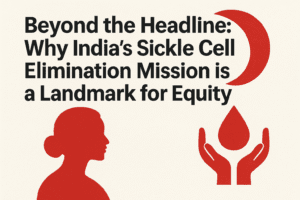Beyond the Headline: Why India’s Sickle Cell Elimination Mission is a Landmark for Equity
India’s National Sickle Cell Anaemia Elimination Mission targets a disease-free nation by 2047, representing a profound commitment to health equity. It directly confronts the disease’s devastating and disproportionate impact on marginalized tribal communities, long burdened by stigma and inadequate care. The mission’s true significance lies beyond medical treatment; it prioritizes prevention through large-scale screening and genetic counseling, comprehensive lifelong care access in remote areas, and actively combating social discrimination.
Aligning the 2047 goal with India’s centenary underscores its symbolic weight as a pledge for dignity. However, daunting execution barriers – including reaching isolated populations, building grassroots healthcare capacity, ensuring sustainable funding, and navigating cultural sensitivities – will determine its success. If implemented effectively, this initiative could transform lives for generations and set a global benchmark for tackling genetic disorders rooted in health inequity. Its ultimate legacy hinges on translating political vision into sustained, community-driven action on the ground.

Beyond the Headline: Why India’s Sickle Cell Elimination Mission is a Landmark for Equity
The announcement wasn’t just another policy tweet. When Prime Minister Narendra Modi shared Union Health Minister Jagat Prakash Nadda’s article on August 12th, 2025, it spotlighted a public health initiative with profound implications: India’s National Sickle Cell Anaemia Elimination Mission (NSCEM) targeting a disease-free nation by 2047.
This isn’t merely about eradicating a disease; it’s a declaration of intent to tackle deep-rooted health inequities. Here’s why this mission deserves attention beyond the political fanfare:
- Confronting a Silent, Stigmatized Burden: Sickle Cell Disease (SCD) is a debilitating, inherited blood disorder causing severe pain, organ damage, and reduced life expectancy. Crucially, it disproportionately affects India’s tribal communities, populations often marginalized and with limited healthcare access. For decades, SCD has been a “hidden” burden, shrouded in stigma and neglect. The mission brings it squarely into the national spotlight, acknowledging the suffering and pledging action.
- More Than Medicine: A Pledge for Dignity: Minister Nadda’s article, highlighted by the PM, emphasizes “ensuring equity and dignity.” This is pivotal. Eliminating SCD isn’t just about providing drugs (like Hydroxyurea) or curative therapies (like bone marrow transplants, which are complex and costly). It fundamentally involves:
- Massive Screening & Genetic Counseling: Identifying carriers before marriage and children are born, empowering informed reproductive choices and preventing new births with SCD. This requires immense community engagement, especially in remote tribal areas.
- Comprehensive Care Access: Ensuring lifelong care – pain management, vaccinations, blood transfusions, specialist consultations – reaches the most vulnerable, often in resource-poor settings. This demands strengthening primary health infrastructure in tribal belts.
- Battling Stigma: Addressing the social isolation and discrimination faced by SCD patients, integrating support and awareness into community health programs.
- The 2047 Vision: Ambitious but Anchored: Aligning the target with India’s 100th year of independence sets a powerful symbolic deadline. However, achieving “disease-free” by 2047 is multifaceted:
- Prevention: Dramatically reducing births with SCD through carrier screening and counseling.
- Management: Ensuring every existing patient has access to quality care, improving life expectancy and quality of life.
- Elimination as a Public Health Problem: Reducing prevalence to a level where it no longer imposes a significant public health burden. This requires sustained, multi-generational effort.
- The Challenges Are Real: The ambition is laudable, but the path is strewn with obstacles:
- Scale & Reach: Screening millions in geographically isolated tribal populations.
- Infrastructure & Workforce: Building diagnostic capacity and training healthcare workers in SCD management at the grassroots level.
- Cost & Sustainability: Ensuring long-term funding for screening, counseling, treatment, and patient support.
- Cultural Sensitivity: Navigating community beliefs and practices around marriage, health, and genetic disorders effectively.
The Genuine Significance:
India’s SCD Elimination Mission represents a potential paradigm shift in public health:
- Prioritizing the Marginalized: It explicitly targets a disease burdening some of India’s most underserved citizens, signaling a commitment to health equity.
- Holistic Approach: It moves beyond purely clinical interventions to embrace prevention, counseling, and social support, recognizing health as multifaceted.
- Long-Term Commitment: Setting a 22-year horizon acknowledges the complexity of genetic disorders and the need for sustained political and societal will.
- A Model for Others: Success could offer a blueprint for tackling other genetic diseases with significant health equity dimensions globally.
The Road Ahead:
Sharing the article is a start, but the mission’s success hinges on relentless execution. It requires:
- Decentralized Action: Empowering state and district administrations, especially in high-burden tribal regions.
- Community Ownership: Partnering deeply with tribal leaders, ASHAs, NGOs, and patient groups.
- Robust Data Systems: Tracking screening, carriers, patients, and outcomes meticulously.
- Research & Innovation: Investing in affordable diagnostics, better pain management, and exploring accessible curative options like gene therapy.
Prime Minister Modi‘s amplification of this mission underscores its national importance. If implemented with the promised focus on equity and dignity, the National Sickle Cell Anaemia Elimination Mission has the potential to be more than a health victory; it could be a landmark step toward a more just and inclusive India by 2047. The world will be watching.
You must be logged in to post a comment.